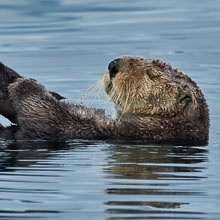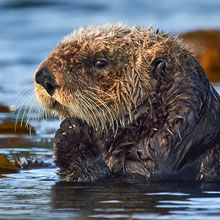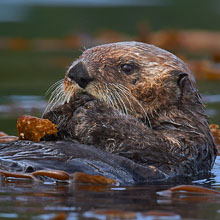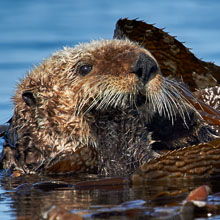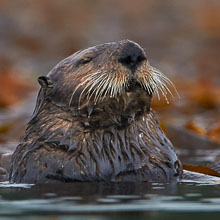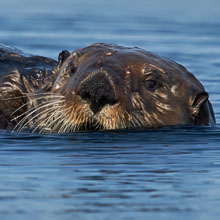Availability: Undetermined - Enquiries?
In the Field
All Wrapped Up. Northern Vancouver Island, BC, Canada. August 20, 2013.
Like many carnivores, sea otters have a profound effect on the ecosystem in which they reside. Besides showing a cute sea otter floating on its back, this image hints at a critical and complicated relationship that sea otters have with bull kelp. Both kelp forests (which are completely analogous to terrestrial forests) and sea otters used to be common on the coast of British Columbia. The kelp forests are critical to huge numbers of species - their long stalks and leaf-like floating blades provide a substrate which form important habitat for hundreds of species of invertebrates and vertebrates to cling to and feed from. Over 30 species of rock fish use bull kelp during some phase of their life cycle. Healthy and abundant kelp forests help create and maintain a diverse and rich marine ecosystem - which can mean everything from effective capture of atmospheric carbon all the way through to assisting in providing food for humans.
When you find a sea otter today, odds are there's a kelp forest nearby. They use the kelp for many things, including as holdfasts to maintain their position in tide currents and stormy conditions. This cute sea otter is doing what so many sea otters do - hanging out in, and fully draped with, bull kelp.
But the relationship between sea otters and kelp goes much deeper than this. About 200 years ago sea otters became much sought-after by humans for their luxuriant coats (with up to 150,000 hairs per sq cm - or almost 1 million hairs per sq inch - sea otters have the densest fur of ANY mammal on earth). By early in the 20th century almost all the sea otters on the BC coast were extirpated by fur traders. Shortly thereafter, kelp forests began disappearing...along with the biological diversity they create and maintain. Why?
Well...it turns out that sea otters have voracious appetites, and eat a lot of shellfish. And one of their favorite shellfish dishes is sea urchin. Now sea urchins themselves consume kelp. In intact marine ecosystems the appetites of sea otters helps keep sea urchin (and other shellfish) population numbers in check. Remove sea otters and what happens? Shellfish, and particularly sea urchins, explode in numbers. And the sea urchins eat themselves out of house and home and, along the way, turn kelp forests into oceanic barrens. And there goes species diversity and abundance...
You'd intuitively think that with such a straight-forward ecological relationship between sea otters and sea urchins and kelp forests (and the obvious positive effect of sea otters on marine ecosystem) that it would be a no-brainer that sea otters should be protected and their return to the BC coast would be welcomed. But...don't forget...like always, humans are involved. In the time between the extirpation of the sea otter and now (about 125 years) humans developed a commercial shellfish on BC's coast (largely because of the "inflated" shellfish numbers owing to the lack of predation by otters). So now when the discussion of sea otter re-introduction comes up, it is met by fierce opposition. Definitely a case of "shifting baseline syndrome" where the "artificial" situation of no sea otters and lots of shellfish (and almost no kelp forests) became the "new norm". Big sigh...
Back to the image: I often like to place my subjects "low" in the frame - effectively "grounding" them. That's partly because I prefer my images to have only one out-of-focus zone in them, and partly because on any landscape the subjects do tend to be low in the scene (there is a pretty massive sky above in most cases!). In this case though, the background got increasingly bright and - in my opinion - distracting. So, I compromised by placing the body of the sea otter close to the vertical mid-line of the image, with the main subject (the otter's head) in the good ol' "power point" specified by the rule of thirds. Not perfection, but a workable compromise (I hope!).
This is one that some might want to use as a screensaver or desktop background...so here's a reasonably hi-res (2400 pixel wide) version of it:
• All Wrapped Up: Download 2400 pixel image (JPEG: 1.4 MB)
ADDITIONAL NOTES:
1. This image - in all resolutions - is protected by copyright. I'm fine with personal uses of it (including use as desktop backgrounds or screensavers on your own computer), but unauthorized commercial use of the image is prohibited by law. Thanks in advance for respecting my copyright!
2. Like all wildlife photographs on this website, this image was captured following the strict ethical guidelines described in The Wildlife FIRST! Principles of Photographer Conduct. I encourage all wildlife photographers to always put the welfare of their subjects above the value of their photographs.
3. This image was captured during my "Humpback, Orcas, Sea Lions & More" photo tour in August of 2013. Each year I offer trips into two different parts of the Great Bear Rainforest as well as one to photograph aquatic mammals and oceanscapes near the northern tip of Vancouver Island. And, in selected years, I also offer photo tours to locations to capture other highly sought-after subjects, such as various owl species of the boreal forest and wildlife of Canada's Arctic. Details about these trips can be found on the Photo Tours page of this website.
Behind the Camera
All Wrapped Up. Northern Vancouver Island, BC, Canada. August 20, 2013.
Digital Capture; Compressed RAW (NEF) 14-bit format; ISO 1100.
Nikon D4 paired with Nikkor 400mm f2.8E VR. Hand-held from floating Zodiac. VR ON and in "normal" mode.
1/1600ss @ f8; No compensation from matrix-metered exposure setting.
At the Computer
All Wrapped Up. Northern Vancouver Island, BC, Canada. August 20, 2013.
RAW Conversion to 16-bit TIFF, including first-pass/capture sharpening using Capture One Pro version 7. Three raw variants (different versions of a single raw capture) processed, differing by a total of 0.8 stops exposure.
Further digital corrections on resulting 16-bit TIFF files using Adobe's Photoshop CC and Light Craft's LightZone. Photoshop adjustments included compositing (blending) of the three exposure variants, selective contrast adjustment to the water (via two selective curves adjustment layers) and sharpening for web output. Final tone tweaking performed using tonemapper/re-light tool in LightZone.
Conservation
All Wrapped Up. Northern Vancouver Island, BC, Canada. August 20, 2013.
Ten percent of the revenue generated by this image will be donated to Raincoast*.
Species Status in Canada**: Special Concern (April 2007) - protected off the North American coast since 1911.
Back in the late 1800's and early 1900's the Sea Otter (Enhydra lutris) was hunted to near extinction along both the Asian and North American Pacific Coasts. The reason? It's luxuriant coat. Otters are unlike any other aquatic mammal in that they don't use fat or blubber to insulate themselves from the chilling effects of the water they are found in. Instead, they rely on their amazingly thick fur coat for insulation. Their amazing coats have a higher density of hair (up to 150,000 strands of hair per square cm!) than any other animal in existence today. To ensure that this coat serves its insulative purpose, otters spend a disproportionately large amount of time grooming their coat (to ensure its natural oils continue to provide an effective waterproof barrier). Unfortunately, the biological functioning of the otters coat can be easily fouled by contamination by oil and other hydrocarbons - thus making them extremely sensitive to the effective of marine oil spills.
Other fascinating aspects of the biology and behaviour of the sea otter include the use of tools (they will use rocks to break apart shellfish such as sea urchins), and the fact that they have an metabolic rate two to three times higher than other mammals of their size. This means they must eat 23% to 33% of their own body weight DAILY, just to to replace the calories burned through maintaining their body temperature in the cold water environment they live in.
*The Raincoast Conservation Society (and Foundation) is an effective and efficient organization that has been fighting for protection of this unique habitat. If you are looking for a meaningful way to contribute to the conservation of this amazing ecosystem, Raincoast will provide maximal "bang" for your conservation dollars.
**as determined by COSEWIC: The Committee on the Status of Endangered Wildlife in Canada



















